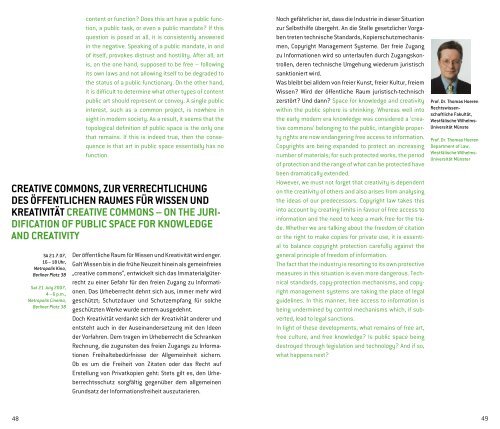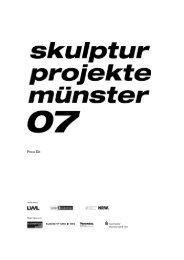Juni bis Oktober 2007 SKULPTUREN landschaft - Skulptur Projekte ...
Juni bis Oktober 2007 SKULPTUREN landschaft - Skulptur Projekte ...
Juni bis Oktober 2007 SKULPTUREN landschaft - Skulptur Projekte ...
Sie wollen auch ein ePaper? Erhöhen Sie die Reichweite Ihrer Titel.
YUMPU macht aus Druck-PDFs automatisch weboptimierte ePaper, die Google liebt.
content or function? Does this art have a public function,<br />
a public task, or even a public mandate? If this<br />
question is posed at all, it is consistently answered<br />
in the negative. Speaking of a public mandate, in and<br />
of itself, provokes distrust and hostility. After all, art<br />
is, on the one hand, supposed to be free – following<br />
its own laws and not allowing itself to be degraded to<br />
the status of a public functionary. On the other hand,<br />
it is difficult to determine what other types of content<br />
public art should represent or convey. A single public<br />
interest, such as a common project, is nowhere in<br />
sight in modern society. As a result, it seems that the<br />
topological definition of public space is the only one<br />
that remains. If this is indeed true, then the consequence<br />
is that art in public space essentially has no<br />
function.<br />
creatIVe coMMons, zur VerrechtlIchung<br />
des öffentlIchen rauMes für wIssen und<br />
KreatIVItät creatIVe coMMons – on the JurIdIfIcatIon<br />
of PuBlIc sPace for Knowledge<br />
and creatIVIty<br />
SA 21.7.07,<br />
16 – 18 Uhr,<br />
Metropolis Kino,<br />
Berliner Platz 38<br />
Sat 21 July <strong>2007</strong>,<br />
4 – 6 p.m.,<br />
Metropolis Cinema,<br />
Berliner Platz 38<br />
Der öffentliche Raum für Wissen und Kreativität wird enger.<br />
Galt Wissen <strong>bis</strong> in die frühe Neuzeit hinein als gemeinfreies<br />
„creative commons“, entwickelt sich das Immaterialgüterrecht<br />
zu einer Gefahr für den freien Zugang zu Informationen.<br />
Das Urheberrecht dehnt sich aus, immer mehr wird<br />
geschützt; Schutzdauer und Schutzempfang für solche<br />
geschützten Werke wurde extrem ausgedehnt.<br />
Doch Kreativität verdankt sich der Kreativität anderer und<br />
entsteht auch in der Auseinandersetzung mit den Ideen<br />
der Vorfahren. Dem tragen im Urheberrecht die Schranken<br />
Rechnung, die zugunsten des freien Zugangs zu Informationen<br />
Freihaltebedürfnisse der Allgemeinheit sichern.<br />
Ob es um die Freiheit von Zitaten oder das Recht auf<br />
Erstellung von Privatkopien geht: Stets gilt es, den Urheberrechtsschutz<br />
sorgfältig gegenüber dem allgemeinen<br />
Grundsatz der Informationsfreiheit auszutarieren.<br />
Noch gefährlicher ist, dass die Industrie in dieser Situation<br />
zur Selbsthilfe übergeht. An die Stelle gesetzlicher Vorgaben<br />
treten technische Standards, Kopierschutzmechanismen,<br />
Copyright Management Systeme. Der freie Zugang<br />
zu Informationen wird so unterlaufen durch Zugangskontrollen,<br />
deren technische Umgehung wiederum juristisch<br />
sanktioniert wird.<br />
Was bleibt bei alldem von freier Kunst, freier Kultur, freiem<br />
Wissen? Wird der öffentliche Raum juristisch-technisch<br />
zerstört? Und dann? Space for knowledge and creativity<br />
within the public sphere is shrinking. Whereas well into<br />
the early modern era knowledge was considered a ‘creative<br />
commons’ belonging to the public, intangible property<br />
rights are now endangering free access to information.<br />
Copyrights are being expanded to protect an increasing<br />
number of materials; for such protected works, the period<br />
of protection and the range of what can be protected have<br />
been dramatically extended.<br />
However, we must not forget that creativity is dependent<br />
on the creativity of others and also arises from analysing<br />
the ideas of our predecessors. Copyright law takes this<br />
into account by creating limits in favour of free access to<br />
information and the need to keep a mark free for the trade.<br />
Whether we are talking about the freedom of citation<br />
or the right to make copies for private use, it is essential<br />
to balance copyright protection carefully against the<br />
general principle of freedom of information.<br />
The fact that the industry is resorting to its own protective<br />
measures in this situation is even more dangerous. Technical<br />
standards, copy-protection mechanisms, and copyright<br />
management systems are taking the place of legal<br />
guidelines. In this manner, free access to information is<br />
being undermined by control mechanisms which, if subverted,<br />
lead to legal sanctions.<br />
In light of these developments, what remains of free art,<br />
free culture, and free knowledge? Is public space being<br />
destroyed through legislation and technology? And if so,<br />
what happens next?<br />
Prof. Dr. Thomas Hoeren<br />
Rechtswissenschaftliche<br />
Fakultät,<br />
Westfälische Wilhelms-<br />
Universität Münste<br />
Prof. Dr. Thomas Hoeren<br />
Department of Law,<br />
Westfälische Wilhelms-<br />
Universität Münster<br />
48 49





